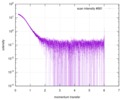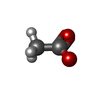+Search query
-Structure paper
| Title | Structural model of the cytosolic domain of the plant ethylene receptor 1 (ETR1). |
|---|---|
| Journal, issue, pages | J Biol Chem, Vol. 290, Issue 5, Page 2644-2658, Year 2015 |
| Publish date | Jan 30, 2015 |
 Authors Authors | Hubert Mayerhofer / Saravanan Panneerselvam / Heidi Kaljunen / Anne Tuukkanen / Haydyn D T Mertens / Jochen Mueller-Dieckmann /  |
| PubMed Abstract | Ethylene initiates important aspects of plant growth and development through disulfide-linked receptor dimers located in the endoplasmic reticulum. The receptors feature a small transmembrane, ...Ethylene initiates important aspects of plant growth and development through disulfide-linked receptor dimers located in the endoplasmic reticulum. The receptors feature a small transmembrane, ethylene binding domain followed by a large cytosolic domain, which serves as a scaffold for the assembly of large molecular weight complexes of different ethylene receptors and other cellular participants of the ethylene signaling pathway. Here we report the crystallographic structures of the ethylene receptor 1 (ETR1) catalytic ATP-binding and the ethylene response sensor 1 dimerization histidine phosphotransfer (DHp) domains and the solution structure of the entire cytosolic domain of ETR1, all from Arabidopsis thaliana. The isolated dimeric ethylene response sensor 1 DHp domain is asymmetric, the result of different helical bending angles close to the conserved His residue. The structures of the catalytic ATP-binding, DHp, and receiver domains of ethylene receptors and of a homologous, but dissimilar, GAF domain were refined against experimental small angle x-ray scattering data, leading to a structural model of the entire cytosolic domain of the ethylene receptor 1. The model illustrates that the cytosolic domain is shaped like a dumbbell and that the receiver domain is flexible and assumes a position different from those observed in prokaryotic histidine kinases. Furthermore the cytosolic domain of ETR1 plays a key role, interacting with all other receptors and several participants of the ethylene signaling pathway. Our model, therefore, provides the first step toward a detailed understanding of the molecular mechanics of this important signal transduction process in plants. |
 External links External links |  J Biol Chem / J Biol Chem /  PubMed:25451923 / PubMed:25451923 /  PubMed Central PubMed Central |
| Methods | SAS (X-ray synchrotron) / X-ray diffraction |
| Resolution | 1.9 - 2.15 Å |
| Structure data |  SASDC42: Ethylene Receptor 1 Cytosolic Domain (Ethylene Receptor 1, ETR1(-ΔTM))  SASDCA7: Ethylene Receptor 1 (DHp + CA domains) (Ethylene receptor 1 dimerization histidine phosphotransfer + catalytic ATP-binding domains, ETR1_DHp-CA)  PDB-4mt8:  PDB-4mtx:  PDB-4pl9: |
| Chemicals |  ChemComp-HOH:  ChemComp-CD:  ChemComp-CL:  ChemComp-ADP:  ChemComp-ACT: |
| Source |
|
 Keywords Keywords | TRANSFERASE / Four helix bundle / Histidine kinase / CTR1 / ER Membrane / ETR1 / ethylene receptor / Cadmium / ADP |
 Movie
Movie Controller
Controller Structure viewers
Structure viewers About Yorodumi Papers
About Yorodumi Papers




